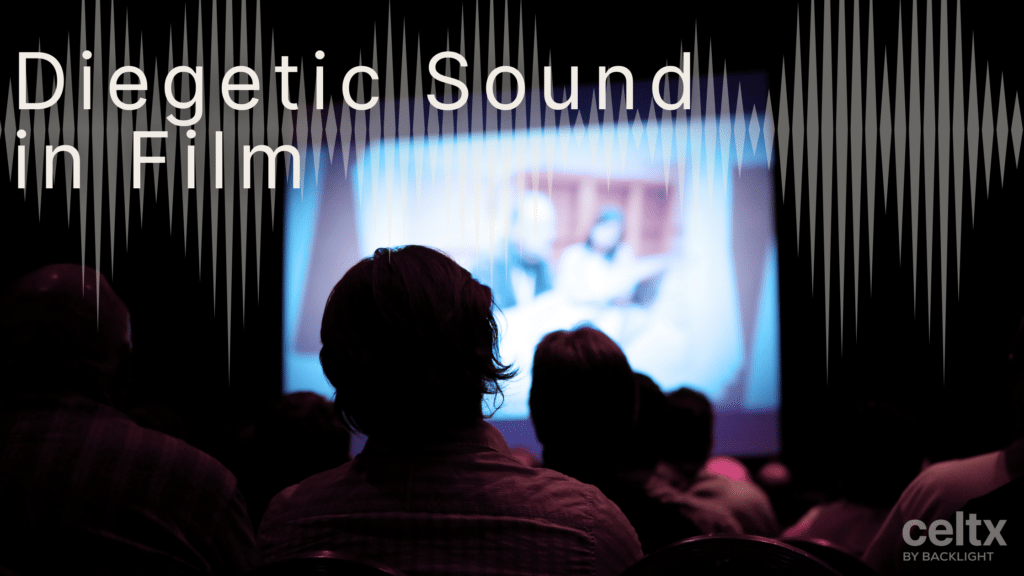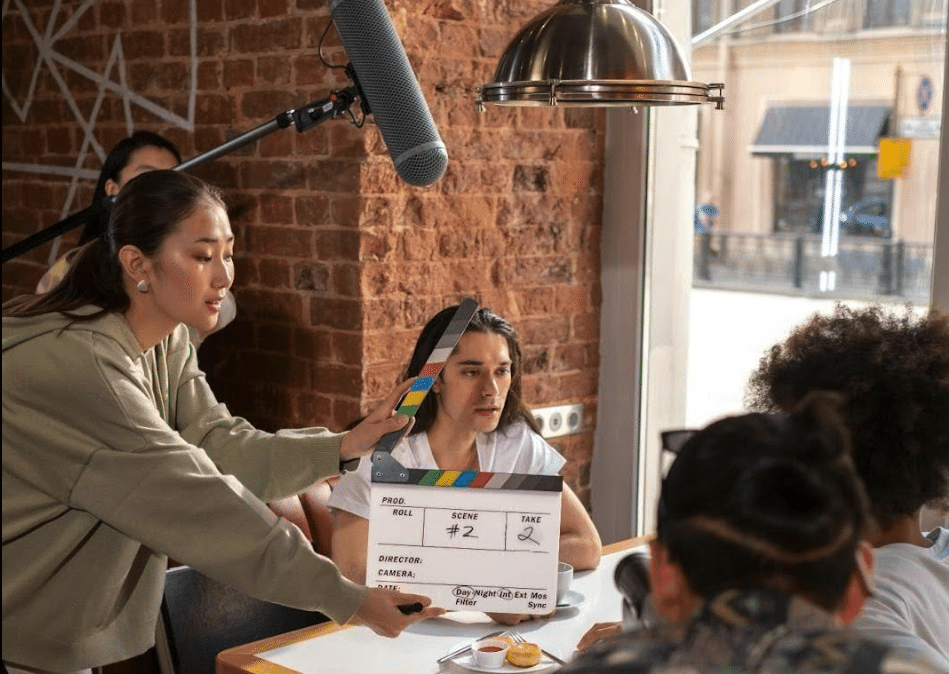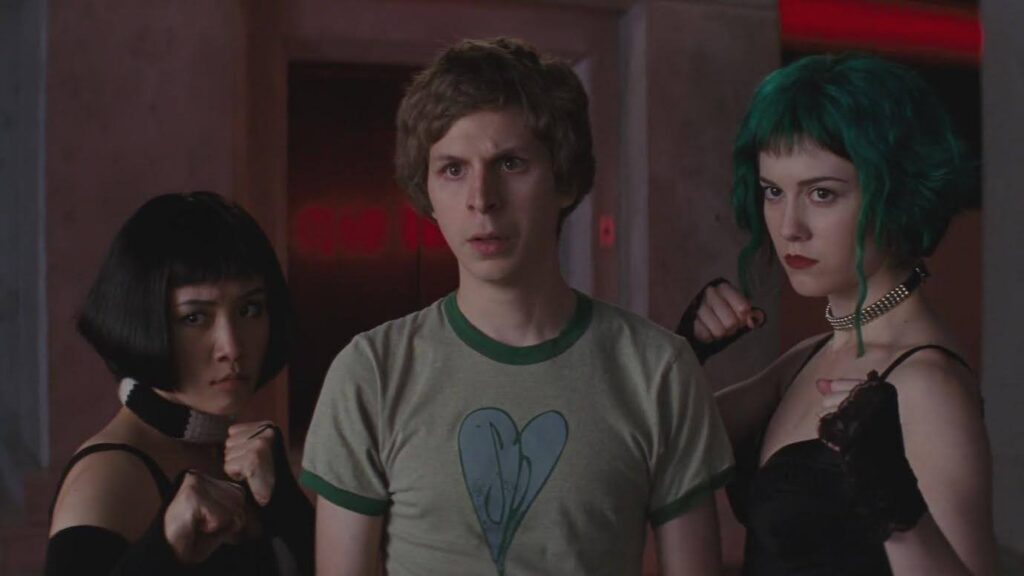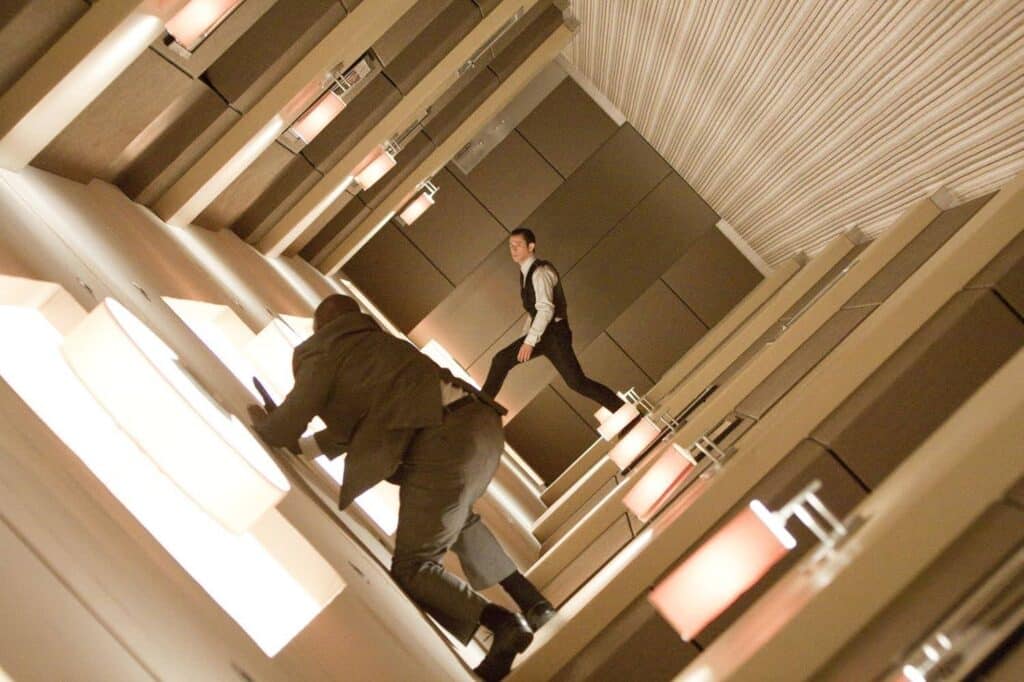
Sound is one of the most powerful elements in filmmaking. From immersing audiences, evoking emotion and establishing tone to enhancing the overall storytelling experience, sound is key in building a scene’s atmosphere alongside dialogue and music.
One such sound concept is diegetic sound. Yes, this may sound technical but is fundamental to cinema.
If filmmakers, screenwriters and all of us cinephiles out there can understand diegetic sound, we can all appreciate how sound functions beyond just background noise. In today’s blog, we’re aiming to do just that.
Read on to find out more about what diegetic sound is, how it differs from non-diegetic sound, and why it’s crucial to storytelling.
Table of Contents:
- What is Diegetic Sound?
- Diegetic vs. Non-Diegetic Sound: What’s the Difference?
- Examples of Diegetic Sound in Film & TV
- Hybrid Sound | When Diegetic and Non-Diegetic Sound Overlap
- How Diegetic Sound Affects Storytelling
- Using Diegetic Sound in Your Own Script
- Conclusion

What is Diegetic Sound?
Ok, so what is diegetic sound?
Diegetic sound refers to any sound that originates within a film’s world. The characters can hear it, and it naturally exists within the scene’s environment.
Did you know that term diegetic originates from the Greek word diegesis, which means ‘narration’ or ‘storytelling’? It’s not a word often encountered outside film studies so is often misspelled as diagetic, diegectic, or diefgetik (this last one influenced by phonetic pronunciations).
Now we know the diegetic sound definition, let’s look at some examples:
Examples of Diegetic Sound
- Dialogue spoken by characters.
- Environmental noises such as footsteps or doors creaking.
- Music coming from a radio or live band within a scene.
- Sound effects like a phone ringing, gunshots, or rustling leaves.
In short, any sound that belongs to the story world.
Diegetic vs. Non-Diegetic Sound: What’s the Difference?
Yes, there is such a thing as non-diegetic sound in movies because not all sounds in a film come from its world. Some are added later to influence the audience without affecting the characters.
So, what’s the difference between diegetic and non-diegetic sound? Our chart below breaks everything down:
| Diegetic Sound | Non-Diegetic Sound | |
| Source | Originates within the film’s world | Exists outside the film’s world. |
| Can characters hear it? | Yes | No |
| Examples | Dialogue, ambient noises, music from an in-scene radio. | Film score, narration, added sound for dramatic effects. |
A prime example of non-diegetic sound is one everyone recognizes: the menacing ‘duh-duh’ music from Jaws (1975). The characters don’t hear it, but the audience does, heighten the tension. Check it out:
Want to bring sound to life in your script?
Celtx helps you format every element of your screenplay seamlessly.
[Start writing today]
Examples of Diegetic Sound in Film & TV
Diegetic sound is utilized in virtually every film and television show. But what are some key examples of diegetic sound?
Next, let’s explore some standout examples across different genres.
Horror | A Quiet Place (2018)
Diegetic sound is crucial to the atmosphere and central tension of A Quiet Place. Since the creatures hunt by sound, every footstep and whisper carries life-or-death stakes. An extreme example of how diegetic sound can shape a narrative itself!
In the movie’s early scenes, it’s the sound from young Beau’s space toy that ultimately decides his fate, as he’s hunted and killed by one of the creatures before his father can save him. An example of how sound alone can change the course of a narrative.
Action | Mad Max: Fury Road (2015)
The roaring engines and chaotic sounds of destruction in Mad Max: Fury Road immerse audiences in the high-octane world. It cleverly blends diegetic and non-diegetic sound – like the Doof Warrior’s guitar playing being both part of the scene and an element of the film’s score.
This not only enriches the story world but also immerses an audience, making them feel like they’re there right with the characters.
Drama | The Social Network (2010)
The bar scene where Mark Zuckerberg discusses Facebook’s potential is filled with diegetic noise, such as the hum of conversation, clinking glasses, and background music. The overlapping noises heighten the tension and realism of the moment.
With drama being very much solidified in reality, the soundscape of scenes like this is extremely important to draw an audience in.
Science Fiction | Blade Runner 2049 (2017)
The atmospheric sounds of rain, humming neon signs, and distant voices in Blade Runner 2049 contribute to the film’s immersive world building. These diegetic sounds used throughout the movie make the dystopian future feel authentic to its audience right from the start:
From dialogue to background noise, every sound choice shapes your story.
Ready to refine your screenplay?
Sign up for Celtx today!
Hybrid Sound | When Diegetic and Non-Diegetic Sound Overlap
While diegetic and non-diegetic sounds are distinct categories, filmmakers can sometimes blur the line between the two for dramatic effect.
This is a technique known as trans-diegetic sound and it occurs when a sound begins as diegetic but transitions into non-diegetic and vice versa. It can have a huge impact on the story.
For example, in Stranger than Fiction (2006), Harold is shocked when he hears the narrators voice which up until this moment in the movie has been voice-over narration that only we as the audience can hear. This change from non-diegetic to diegetic sound in an instant, changes the course of the narrative.
In this clip from Better Call Saul (2015), we go the opposite way, from diegetic to non-diegetic sound. We hear Saul hum the tune to Smoke on the Water by Deep Purple, before it transitions into a full-blown soundtrack, over the top of the action and not originating from the scene itself.
Case Study | The Dark Knight (2008)
Next let’s break down how Christopher Nolan’s blockbuster uses a hybrid approach to build tension in the Joker’s interrogation scene at Gotham’s police station.
Here, the Joker’s eerie theme, composed by Hans Zimmer, starts as a subtle diegetic sound and transitions into a non-diegetic element.
Step 1 | Diegetic Sound
Initially, the scene is filled with realistic, in-world sounds such as the flickering overhead lights, Batman’s footsteps, and the Joker’s restrained laughter.
Step 2 | Emerging Tension
As the Joker taunts Batman about how he has “nothing to threaten (him) with,” a single, almost imperceptible high-pitched note begins. At first, it could be mistaken for an environmental hum or electrical noise.
Step 3 | Gradual Escalation
This note starts to build and intensify, seamlessly blending into the film’s score. While still subtle at this stage, it becomes a fully non-diegetic element designed to unnerve the audience and mimic the Joker’s psychological control.
Step 4 | Emotional Payoff
When Batman slams the Joker against the wall, demanding to know where Rachel is, the sound peaks, fully transforming into a non-diegetic score. Here, the scene’s chaos and urgency reach its climax, with the Joker’s unsettling presence and manipulation taking hold.
Let’s see the scene play out in full:
See how sound fits into your scene before it hits the screen. Celtx’s storyboarding software helps you map out every shot, including key diegetic sound moments.
Start storyboarding today!
How Diegetic Sound Affects Storytelling
Now we’ve explored some examples of how diegetic (and non-diegetic) sound is used in storytelling, let’s dive deeper into how it affects storytelling overall. Just how does it make films and television more impactful?
Immersion and Realism
Diegetic sound makes a scene feel more believable. Imagine a city scene without the chatter of pedestrians or car horns. It would feel extremely unnatural. This is why sound is considered even in the early stages of a movie’s pre-production, to ensure that it blends seamlessly with the action and dialogue happening on screen.
Even in animated films, diegetic sound helps ground fantastical worlds and draw us in, making us never want to leave.Take Scott Pilgrim, a character who’s world is filled with pop culture and video game sounds that many an audience member can resonate with. Sound editor Julian Slater discussed the sound design for Scott Pilgrim vs. the World with Designing Sound and how it enriches the story world.
Actually, as a percentage very little of the game sounds you hear in the movie are lifted from the actual video games. There are some from Zelda, Sonic, and Super Mario Bros but pretty much everything else was created from scratch. If you go way back to the early 80’s many game sounds were created from pretty basic chips and as such are quiet easy to replicate or recreate with a similar feel. One of the tasks we had was making each sound complement what was happening on screen. If you are a retro gamer like myself, your brain inherently associates those old 8 bit sounds with particular graphics or images so when you apply new images to this (particularly with such vivid visuals as we had) your brain has problems coupling the old sounds with the new images. So we spent a fair amount of time experimenting and seeing what sounds, old or new, would work within the context of the scene. Bill Hader’s voice is featured heavily in the ‘Ninja Ninja Revolution’ game that is a new spin on the popular dance game in arcades. The game looks like a real game but it’s not, it’s all a recreation so all those ‘in game’ sound effects are totally new. Once we had edited and mixed the sounds afresh, we actually worldized them through an old arcade machine that had sitting in my garage for the past 6 years! – Julian Slater

A blend of synthetic and organic diegetic sound was used in the recent Oscar-winning animated movie The Wild Robot. Composer Kris Bowers spoke to Deadline about how protagonist Roz was portrayed as a synthetic being in a very natural and untouched world.
There were basically two sides, the organic and the synthetic, thinking about Roz being the synthetic and being in this very natural environment. I first thought about nature because it’s the predominant energy in that balance of the two. I wanted to find a way to represent that in an unorthodox way, but also in a way that still honored the high level of musicality that I wanted the orchestra to have, just because of how much they were going back to traditional animation in the way that this looked. – Kris Bowers

Emotional Impact
The way sounds are presented can intensify emotions. For example, a creaky floorboard in a horror movie can create dread, while a bustling café in a romance film sets a warm and intimate tone.
Narrative Function
As we’ve seen in some of our examples, sound can also play a big part in driving the plot forward. For instance, in Inception (2010), the ticking of a watch signals the passage of time within the dream world, providing crucial information to both the characters and audience.

Using Diegetic Sound in Your Own Script
As filmmakers and screenwriters, incorporating diegetic sound into our work effectively can elevate our storytelling. Here are some ways you can use it in your next project:
- Enhances World Building
Think about the setting of your story and what sounds define it. A busy newsroom will sound different from a haunted house. Carefully chosen diegetic sounds can make locations feel distinct.
- Uses Sound as a Plot Device
Sound can be more than background noise, as it can play an active role in the story itself. A ringing phone that goes unanswered, a door creaking at the wrong moment, or a song playing on a jukebox can all contribute to tension and foreshadowing.
- Balances Sound and Silence
Sometimes, the absence of diegetic sound is just as powerful. Silence can heighten suspense or even emphasize a character’s isolation in a scene. Take films like No Country for Old Men which masterfully uses silence to build tension.

Sound design starts on the page. Use Celtx’s script writing software to craft immersive scenes with diegetic and non-diegetic sound.
Conclusion
Diegetic sound is a fundamental element of filmmaking that often goes unnoticed but plays a crucial role in shaping the audience’s experience. By distinguishing between diegetic and non-diegetic sound, filmmakers can craft immersive, emotionally engaging, and narratively rich scenes.
Whether you’re watching a film or writing your own, paying attention to how sound functions within the story world will deepen your appreciation for this essential cinematic tool. Next time you watch a movie, take a moment to listen—what sounds exist within the scene, and how do they affect the storytelling? You might be surprised by how much they contribute to the magic of cinema.
Whether you’re writing your first script or your next big project, Celtx’s script writing software makes it easier to bring your vision to life. Click below to start your free trial today!
Enjoyed this article? Try these next:
- Why Storyboarding Still Matters in 2024 (Even with AI Tools)
- Setting the Right Tone: Mastering Tone in Your Screenplay
- What is a Motif in Film? Themes & Symbols Explained

